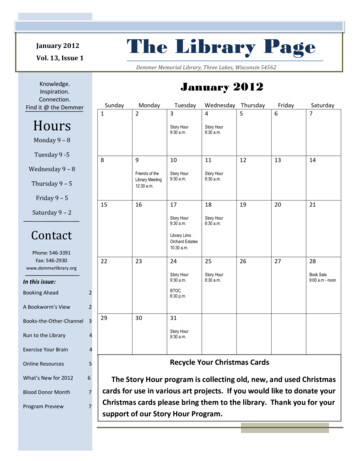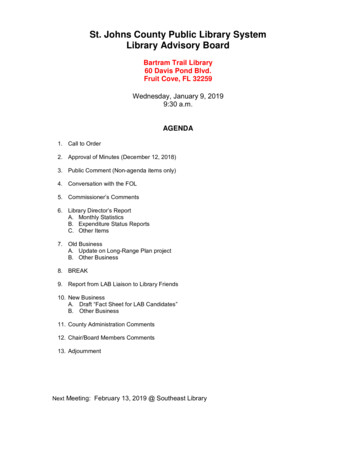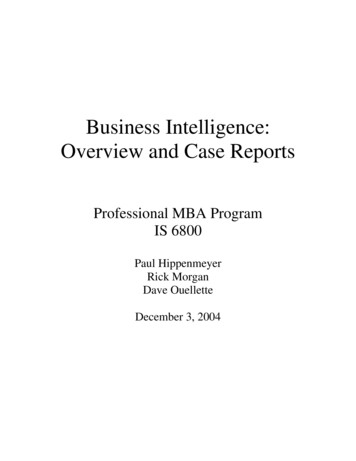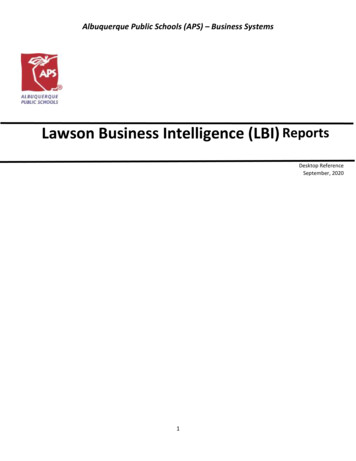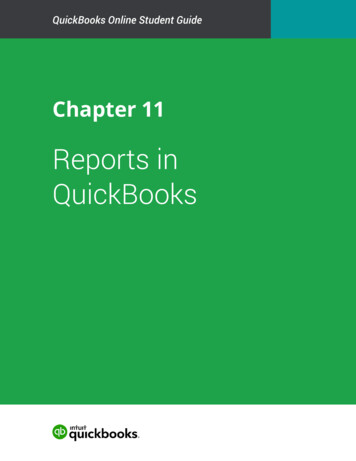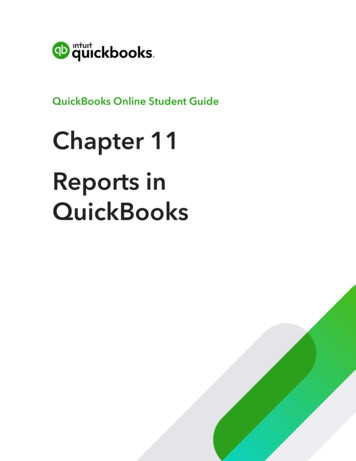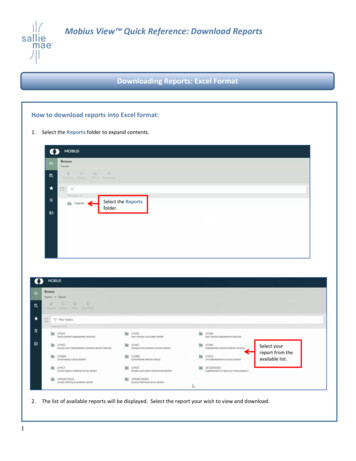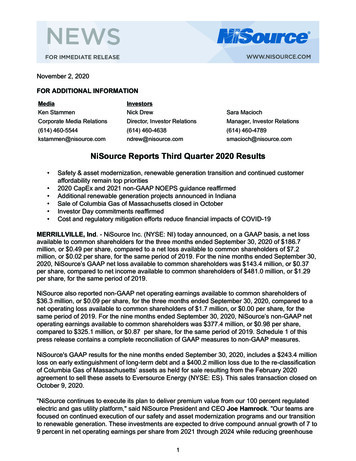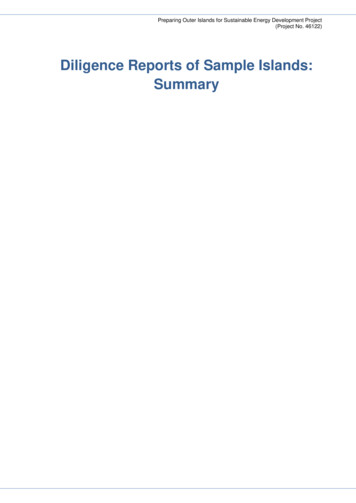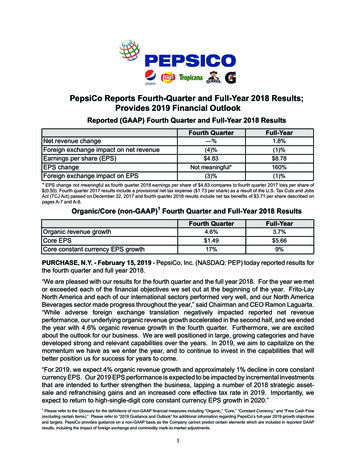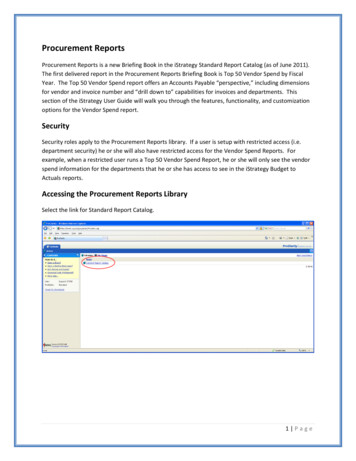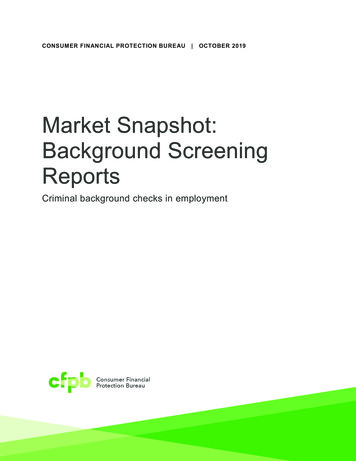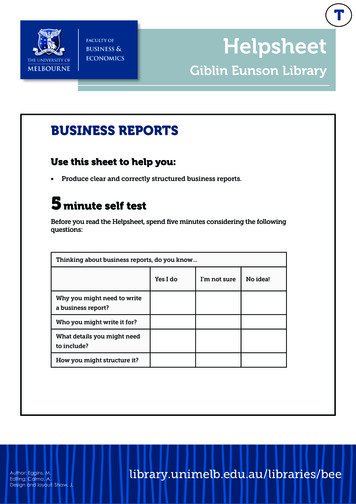
Transcription
THelpsheetGiblin Eunson LibraryBUSINESS REPORTSUse this sheet to help you: Produce clear and correctly structured business reports.5 minute self testBefore you read the Helpsheet, spend five minutes considering the followingquestions:Thinking about business reports, do you know Yes I doI’m not sureNo idea!Why you might need to writea business report?Who you might write it for?What details you might needto include?How you might structure it?Author: Eggins, M.Editing: Calma, A.Design and layout: Shaw, J.library.unimelb.edu.au/libraries/bee
BUSINESS REPORTST1. What is a business report?Organisations need accurate, timely, objective and concise information to makeeffective decisions. One way they can obtain such information is from a businessreport. This document can be defined as “an organised presentation of information toa specific audience for the purpose of helping an organisation achieve an objective”(Bowman & Branchaw, 1988, p. 12).While business reports share similar characteristics, they also need to be customisedfor their particular purpose. An informal report may be a brief summary while longerreports follow a more complex and formal structure.Informal reports may feature: letter or memo formatminimal use of headings and visual aidspersonal pronouns and contractionsa length from a few paragraphs up to five pagescontent primarily for internal audiencesMore formal reports however tend to have: a more standard format organised into separate sectionsfront and back matter (sections) along with the body of the reporta greater number of headings (including subheadings) and visual aidsthird person pronouns and no contractions or slanga length from five pages to several hundredcontent designed for internal and/or external audiences2. Why do I need to write a business report?Formal business reports often feature in university assessment tasks in disciplinessuch as accounting, management and marketing as writing such reports is anessential skill in business. These tasks may require giving information only (i.e.financial statements), information and interpretation (i.e. product surveys) or offeringinformation, analysis and recommendations.A report that details the last type could highlight a problem and suggest a solutionwhich might involve analysing a business’s history, operations, problems, competitionand goals, followed by a number of possible solutions (including their advantagesand disadvantages). Following this investigation, a specific solution might berecommended to aid future growth.Please note that business reports have some of the same features as research reports.For more information on the latter please see the Study and Research Helpsheets Research Reports and Report Checklist.Page 1library.unimelb.edu.au/libraries/bee
BUSINESS REPORTST3. How do business reports differ from essays?An accessible reader-centred style which includes standard formal English is ahallmark of academic writing including in essays or reports. However, there are somekey differences between the two genres:PurposeFormat & Struc-EssaysBusiness ReportsArticulate a point of view in rela-Often recommend action to solvetion to a particular propositiona specific problemHave introduction, body and con-Always have sections clearlyclusion sections that normally dodivided by numbered headingsnot use headings(and often sub-headings)tureUse cohesive paragraphs to linkideas rather than list dot-pointsTypically don’t normally need anAbstractabstract as readers read the textcarefully from start to finishGraphicsWriterReaderRarely use graphics as writtenevidenceAre generally the result of individual workAre written for the lecturer/tutoror other academic audiencesUse shorter, more concise paragraphs and dot-points whereapplicableAlways have an abstract (orexecutive summary) as readers aretypically ‘time poor’ and skim andscan through the text quicklyFeature graphics (such as tablesand graphs) for supporting mainpointsAre often the result of group workAre addressed to a specificaudience (i.e. client or manager)established by the topicPage 2library.unimelb.edu.au/libraries/bee
BUSINESS REPORTST4. How do I write a business report?There are several major steps typically involved in writing a business report. Theseinclude:1)2)3)4)5)planning (including determining the scope and target audience)researching, organising, evaluating and analysing your information sourcesdrafting the body sectiondevising conclusions and recommendations based on the findingsfurther drafting and editing/proofreadingYou need first to consider exactly what you have been asked to do - that is - the overallpurpose of your report. Carefully considering the assessment task and related criteriashould help you clarify: your objective and readershipwhat information you needthe format and level of detail requiredFrom this, prepare an outline (including a working title and the overall structure of thereport, including the major and supporting ideas). Start on your draft early so you candevelop your ideas (editing can come later).Who is your audience?Your readers are your priority. Note that while business reports are typically written by‘specialists’ for ‘generalists’ (most commonly the decision-makers in organisations),there can be a number of audiences for any one report.Therefore carefully consider your readers’ likely: prior knowledge and experience with the background information, technicallanguage, concepts and contexts covered in the reportinterest in and possible opinions regarding the report’s topicAsk yourself the following questions: What do my readers know and think about the topic?What background, definitions and other information do they need?What questions or objections might they raise about the issue/s?Is my audience ‘internal’, ‘external’ or both?- Is it for readers up, across or down the hierarchy of the organisation and/orpeople from outside?Page 3library.unimelb.edu.au/libraries/bee
BUSINESS REPORTSTIf you can identify and assess your audience well, then you can match your content,visuals and structure to their level of expertise. Keep in mind for example that thehigher up the chain of command a report it goes, the more condensed and formal itshould be. A more general audience, in contrast, needs less technical vocabulary andmore explanation. In addition, if writing the report as a group, ensure consistency byagreeing about content, structure and presentation (including fonts and headings, linespacing and indenting) before drafting and also allocate each group member a specificrole (including what area they need to research).How should I begin gathering information?Along with your key audience, you will also need to establish the key conceptsand issues you are dealing with to generate keywords for your research. Considerwhether or not your report needs either primary and/or secondary data. The formerdepends on first-hand sources from your own research (i.e. interviews, surveys andobservations) while secondary research involves using existing information based onother people’s investigations.Allow time to read widely to locate the best resources remembering that your reportshould be supported by documented sources which are authoritative, current, reliableand relevant. In particular, to ensure objectivity, if you are doing a report on aparticular organisation, don’t solely rely on information from them.If you quote, paraphrase, or summarise someone else’s ideas, acknowledge themappropriately. This will usually include indicating 1) the family name of the author, 2)date of publication, and 3) the page number when used in the text. Record these detailson a separate page too at the end of the report in your reference list where you need toinclude other information such as the title, publisher and city of publication. Keepinga ‘research diary’ (listing such useful information as your keywords, successful searchstrategies and notes about indexes/databases) is also recommended.To ensure you have researched widely, use the library catalogue and the Discoverysearch function - the catalogue lists book and journal titles (both paper copies andelectronic) while Discovery gives you access to databases, allowing access to fulltext articles and also includes company, country and industry reports, data andstatistics. The library also has lots of other assistance available including individualresearch consultations and the specialist librarians at the Gilblin-Eunson Business andEconomics Library.What format and structure should I use?As you begin taking notes it is useful to arrange an outline of your report – especiallyits particular sections – so you can ‘fill in’ these as you go along (leave the introduction,conclusion and recommendations for later). Focus here on your ideas, evidence andlogical flow. Dividing your report into sections also ensures the information in yourreport is easy to find and follow. Sections need to be clearly labelled with headings andsub-headings outlining the logical development of your paper. Always check to findout what is required including the format and length of your sections.Page 4library.unimelb.edu.au/libraries/bee
BUSINESS REPORTSTThe flow of information in your report can be organised in two basic ways – indirectlyor directly. The indirect approach (normally required at university) means you needto persuade your readers to accept the findings of a report. This basic structure is 1)background, 2) findings, 3) discussion, 4) conclusions and 5) recommendations. Adirect style however presents the conclusions and recommendations first followed byan introduction and the findings (it is often favoured in the business world for ‘timepoor’ audiences).How should I use headings?Whether you have an indirect or direct structure, headings help organise your report.If one particular section has a number of components to it, consider sub-headingsunder your main heading if necessary. Make sure however, this is done logically sothe connections are clear and the use of font size and style, along with underliningand capitalisation is consistent (headings normally only have the first letter of the firstword capitalised unless proper nouns are also used).You can use either functional headings or more descriptive ones that incorporatecontent. The former ‘generic’ type focus on what each section does (as in‘Introduction’, ‘Findings’, ‘Summary’) whereas descriptive headings reflect contentmore explicitly. Some reports may combine both, generally starting with the formercategory as in ‘Findings: what our survey tell us about our customers.Try and keep headings short, relevant and consistent. Your headings could usestand-alone verbs or nouns, adjectives and nouns together, or even more complexconstructions like clauses – including statements and questions. Some examples arebelow:Sample Headings (Noun and noun groups)IntroductionBackground to the issueService changesProductivity improvementsFuture developmentsConclusionsRecommendationsSample Headings (more complex noun groups & clauses)Why did ABC merge with XYZ?The main issues related to ABC/XYZ merger implementationWhat can be done to improve any merger problems?Should ABC consider any other mergers?Specific recommendations for actionPage 5library.unimelb.edu.au/libraries/bee
BUSINESS REPORTSTWhatever headings you use, repeat some or all of the information in each heading inyour first sentence underneath it rather than using the headings as an introduction toyour text:Issues with the merger A number of issues arise relating to the merger concerning both organisations. These are arising from considerations relating to both organisations.Headings are normally numbered both in the contents page and the text itself. Thissystem uses a combination of numbers and decimal points to do this (see the examplebelow). Do this consistently for all headings and subheadings, using indenting toshow the divisions:1. Current Market Penetration1.1 Australia1.1.1 Sydney1.1.2 Melbourne1.1.3 Other states1.2 Asia Pacific region1.3 Other international markets2. Possible Expansion Strategies2.1 Online2.1.1 Company website2.1.2 Other Internet shopping options2.1.3 Social media and ‘virus’ marketing2.2 Television2.1.1 Product placement2.1.2 Celebrity endorsements2.1.3 Sponsorship5. What are the particular sections of a businessreport?In terms of the elements of a formal report (that uses an indirect approach) there arethree basic parts:Page 6library.unimelb.edu.au/libraries/bee
BUSINESS REPORTST1) Front Matter Cover Title Page Executive Summary Table of Contents List of Figures2) Body of the Report Introduction Findings and Discussion Conclusions Recommendations3) Back Matter Appendices References Glossary (if required)Front MatterThe front matter includes the cover, a title page, an executive summary (abstract),a table of contents, and a list of figures (if you have more than five). A letter oftransmittal - a kind of official ‘cover letter’ - is sometimes required in the businessworld (not normally a university requirement). Note that all pages in the front matterare numbered using small Roman numerals.Title pageWhen considering the actual title of your report ensure that it is somewhat neutral andthus does not imply any particular pre-determined outcome. Your title page shouldcomprise: the full title (centred, in bold or upper case)the person/organisation it was prepared for (optional)the person or people who prepared it (and student numbers where required)the due datethe lecturer/tutor’s namethe name of the subject (and its code)no page number (but is counted as a page)While the above is a general guide, please check with your lecturer/tutor as eachassessment task may have its own specific requirements:Page 7library.unimelb.edu.au/libraries/bee
TBUSINESS REPORTSTable of contentsIf your report is over several pages, a table of contents helps readers to locateinformation quickly by giving them an overview. All section headings andsubheadings should be included, worded and numbered exactly as they appear in thetext. You might include a list of illustrations on a separate page (if you have more than5 graphic aids). A list of appendices needs the appendix letter (each separate appendixlabelled as Appendix A, Appendix B, etc.), its title and page number. A glossary mayalso be required if you have a large amount of unfamiliar vocabulary, symbols,abbreviations and/or acronyms.Table of ContentsPage1.Introduction 12.An overview of the product12.1 Main features13.4.Product benefits 23.1 Reducing heating costs23.1.1 Heating cost reductions by season23.1.2 Further savings through thermostat use33.1.3 Other associated savings43.2 Improving house resale value43.3 Reducing household bacteria5Advertising strategies4.1 Traditional media54.2 Web 2.065.Conclusions 66.Recommendations 6Bibliography 7AppendicesA. Product development specifications9B. Advertising budget10Executive summaryAn executive summary or ‘abstract’ is very important as some readers may onlyread this part. Write it last, being sure to include a summary of all parts of the report(omitting examples unless essential) including the:Page 8library.unimelb.edu.au/libraries/bee
BUSINESS REPORTS T‘why’ (purpose)‘what’ (scope or breadth of the investigation)‘how’ (methodology)‘what you found out’ (major findings with key statistics)‘so what’ (analysis, conclusions and recommendations)It should be a half to one page (around 5% - no more than 10%) of the overall length andon a separate page.BodyIntroductionYour introduction is really the ‘start’ of the report so describe here why your report isbeing written answering such questions as ‘what is this about?’ and ‘how is it useful?’This is also where your page numbering starts. Specifically you need to: give some brief background informationdefine the problem/topic, its relevance, scope and any key termsstate the overall purpose (are you explaining, analysing, recommending or acombination?) and key objectivesgive an overview of the report’s structure including the sections and theirrelationship to the issuesdetail assumptions, theoretical foundation, scope, methodology and anylimitations or constraintsAs this section details the whole structure of your report, you may wish to do it lastwhen most of the report has been written.Findings and discussionIn your findings and discussion sections, present a factual outline followed by aninterpretation of what you found. Note that a frequent complaint from lecturers isthat there is too much description and not enough analysis regarding what findingsactually mean. This section is usually the longest part of a report and forms the basis ofyour conclusions and recommendations. As a result, record all significant information(both positive and negative) and ensure you have a logical internal structure – thiscould be based on such organisation as chronology, order of importance, general tospecific, regions or topics.Findings can be presented in text and/or graphically. If using graphs or figures, seethe relevant section in this helpsheet for more detail on how to do this. This sectionshould reflect the structure outlined in the introduction. It may try and answerquestions like: What were the most significant findings or factors involved in the topic/ problem?Did the findings support the theory?Did you uncover any unexpected or new issues that need to be considered?Page 9library.unimelb.edu.au/libraries/bee
BUSINESS REPORTSTTo discuss such questions you may include: support that the results provide for the hypothesesa comparison of results with other relevant theory and/or investigationsfactors which may have influenced your results, e.g. design problemsimplications of the resultsEnsure that you do more than just describe – instead make it clear the significanceof what you are talking about and how it might relate to the conclusions andrecommendations. Phrases such as ‘therefore it is clear that X is important in Y’ or‘With this result in mind, it follows that X is ’.ConclusionYour conclusion summarises your study - its purpose, process and findings. You needto include your main ‘opinion’ here, answering the questions raised by your originalpurpose so there is a thematic unity to your report and the recommendations followlogically. You may also need to consider the limitations and advantages of findingsand any unresolved questions or issues. Avoid including any new information.Adjectives are useful in a conclusion as a way of condensing your main points:‘This report therefore clearly highlights that the advertising campaign was verysuccessful, due to its inclusive and far-reaching impact with key target audiences suchas X and Y’.RecommendationsRecommendations are the suggested actions based on the report findings. They mustbe both relevant and feasible covering: What needs to be doneWho needs to do itHow, when (in what order if appropriate) and where it needs to be doneRecommendations could be for change, improvement or new ideas to improve suchareas as service, productivity or performance. They can be listed one at a time (oftennumbered). Be sure you use a consistent sentence structure for all recommendations(some examples are below). Think carefully also about the order they are in andwhether or not it would be useful to group them into appropriate content areas.These include: verb (directive)Hire more technical staff to deal with the ongoing quality control issuepassive with ‘it’ as the ‘dummy’ subjectIt is highly recommended that more technical staff be hired to deal withthe ongoing quality control issuePage 10library.unimelb.edu.au/libraries/bee
BUSINESS REPORTS Tspecific subject in passive voiceTechnical staff should be hired to deal with the ongoing quality control issuespecific subject in active voiceManagement consider alternative funding arrangements for the new ventureBack MatterAppendicesYour appendices (if required) contain optional material at the end of your report,containing specialised (sometimes technical) information that may have been toodetailed or lengthy to include in the body. Appendices can be in any format, however,each appendix must be separate from the others, covering only one kind of contentand format on separate pages. They are generally distinguished by letters of thealphabet – e.g. Appendix A, Appendix B, Appendix C, and can be referred to in the textof the report (i.e. “for the full list of suppliers refer to Appendix B”).ReferencesIt is essential to include an accurate reference list of the material you used in yourreport. You will need references when you have included any material (includingstatistics, facts and opinions) which is not yours. As there are several referencingsystems, check with your lecturer, tutor or department for guidelines on how toreference and do this accurately and consistently as lecturers will notice mistakes inthe reference list.6. Do I need to add tables and figures?Adding graphics to your report such as charts (pie, bar, line, organisational andflow), tables and timelines is a useful aid for your readers. This is because they canmore clearly illustrate and reinforce your main points (especially for comparisonsand projections). They are most commonly used in the findings section if they areessential to understanding the text. If they are more ‘supplementary’ (such as rawdata), put them in the appendices. In any case, they should: be clearly and consistently labelled (i.e. x and y axis with the table title flush leftwith any source required) and referenced if taken from an outside sourcebe placed as close to the written text they match to avoid confusionfeature distinct shading if the report is printed in black and whiteIn addition, think carefully about how important the information is – that is doyou want to include visuals in the body of the report to support your text or in theappendices for further reference?When referring to visuals, subordinate them to your main idea as in ‘As Table 1shows ’, ‘As shown in Table 2,’ or highlight as in ‘Table 1 demonstrates ’ or ‘Figure 2clearly indicates’. Moreover, be consistent with table and figure titles (in most cases,table titles precede the tables while figure titles follow the figures). Do not leave thePage 11library.unimelb.edu.au/libraries/bee
BUSINESS REPORTSTreader to interpret your data, but rather supply explanations in your text, e.g. ‘Table 1shows the proportion of consumers who did not take up the premium plan option’.Industry PlayersHarvey Norman HoldingsLimitedOwnershipPublic ParentJB Hi-Fi LimitedPublic ParentThe Good GuysPublic SubsidiaryDick SmithPublic SubsidiaryStrathfield GroupPublic CompanyVideo EZYPrivate CompanyBlockbusterUS Based CompanyTablesTables show information (words and/or numerical data) in rows and columns. They areespecially useful in portraying details, relationships and comparisons.Table 1: Industry Players by OwnershipSource: Melbourne University Department of Accounting and Business InformationSystems (2010).GraphsVertical bar and line graphs are usefulto demonstrate trends. More complexinformation can be segmented or bepresented using multiple bars.Figure: Vertical Bar Graph (segmented)Figure 3. New Store Sales Growth Rate vsComparable Store Sales Growth RateSource: Calma Corporation (2010)Page 12library.unimelb.edu.au/libraries/bee
TBUSINESS REPORTSFigure: Multiple Vertical BarGraphFigure 4. Financial Performance:Percentage of Net IncomeSource: AC Holdings (2010)Language for discussing tables and graphsUse appropriate language to refer to the significant details in your charts and tables.Verbs like ‘show’, ‘refer’, ‘highlight’ and ‘underscore’ help emphasise the points in yourvisuals: This figure refers to the domestic sales only, however. The last two bars in the bar graph represent the strong increase in shareperformance across the whole portfolio. The strongest performing affiliate is X as highlighted in Graph YVerbs to use in describing tables and figuresarticulate, demonstrate, describe, illustrate, represent, showaccentuate, affirm, agree with, assert, emphasise, establish, highlight, maintain, stress,suggest, support, underscorecontradict, disagree with, dispute, refuteWhen you are commenting on trends, you can choose from at least two basic patterns.Describing trends: two basic grammatical patterns12SubjectVerb(specific)Adverb There’)‘be’ verbArticle‘a’or .The table on the following page contains some words you can use for the two patternsmentioned above to describe trends.Page13library.unimelb.edu.au/libraries/bee
BUSINESS REPORTSTWords to describe trendsAdjectives (can also be changed to become adverbs)Small changeconstant, gentle, gradual, incremental, insignificant,minimal, moderate, modest, slight, slow, small, steadyLarger changeabrupt, dramatic, enormous, erratic, large, marked,notable, overwhelming, sharp, significant, steep,substantial, sudden, swift, wildNouns (can also be changed to become verbs)Increase ascension, ascent, climb, doubling, growth,improvement, increase, jump, lift, peak, recovery, rise,rise, rocket, surge, triplingDecrease crash, decline, decrease, deterioration, dip, drop, fall,fall, nosedive, plummet, plunge reduction, slide, slump,weakeningFlattening or then bottoming out, levelling off, plateauFluctuation difference, fluctuation, movement, variationTo back up your claims, you may want to give extra information from the graph orfigure such as a statistic (which may be a precise figure or an approximation) and therelevant time period.SubjectVerb(specific)Statistic time periodSalesincreased by one quarter/about 25%/over 20 000 units last year. to over two million dollars/to their highest level since last year. in all outlets, from just under 20% in 2007 to 25% in 2008, risingagain in 2009 by 10% to a peak of 35%.Page 14library.unimelb.edu.au/libraries/bee
BUSINESS REPORTST7. How can I make my report reader-friendly?Once you have completed a first draft, look more closely at your style, language,grammar and presentation. Check other members’ sections in the final draft to ensurethey have adhered to agreed specifications - and all members understand all thecontent!Some specific ways you can make your report ‘reader-friendly’ include:Presentation an easily read and consistently applied fontnumbered headings and generous use of white space (in margins and at the topand bottom of each page as well as to separate each section)consistent use of abbreviations and acronymsStructure one main idea per paragrapheach paragraph having a clear topic sentenceshort introduction and conclusion paragraphslonger body paragraphs that develop main pointsa strong and concise conclusionan overall ‘theme’ running throughout the paper – possibly a statement or aquestionLanguage specific, concise and clear languageconsistent and accurate verb tenses:simple tenses (usually the present simple) to express facts, current actions andconclusionspast tense for completed actions and referencespresent perfect for things happening in the past up to nowavoidance of emotional language and jargonthe active voice with short sentences and clear actors and actions using specificverbs and adverbs favoured as in ‘Company X considered the plan carefully’avoidance of too many sentences starting with words like ‘considering’ and‘having’ instead briefly subordinating already known information as in:‘Since X Corporation began operating in this region, some issues have arisenthat have impacted on profits’.Page 15library.unimelb.edu.au/libraries/bee
TBUSINESS REPORTS8. Business Report ChecklistYes ( ) or No ( )Business Report ChecklistAudienceHave I clearly identified who my readers are?Do I know their prior knowledge about the topic?Have I identified what they need to know?Will they understand my vocabulary?ContentHave I used a variety of information sources?Are my sources relevant, credible, current and referenced appropriately?Do I have a clear objective that has been met?Can I put some of my data in the Appendices?Have I been specific enough – using specific contexts, terms and figures?Do my conclusions and recommendations flow logically from myfindings and discussions?If the report was written as a group do I (and other group members)understand all the content?Language & StyleHave I used strong, clear and short introductions, main points andconclusions?Do I have just one main idea per paragraph?Do I have a clear topic sentence for every paragraph?Have I been objective? – that is have I used the third person and theappropriate level of formality (no contractions, slang, emotionallanguage)?PresentationHave I been consistent in my use of: headings fonts punctuation bold bullet points italics abbreviations acronyms numbering?Does my presentation overall assist the reader in making the report easyto follow?Page 16library.unimelb.edu.au/libraries/bee
BUSINESS REPORTSTReferencesBowman, J.P. and Branchaw, B.P. (1988). Business Report Writing, 2nd ed Chicago: TheDryden PressCanberra University (n.d.) Academic Skills Centre: Report Writing. RetrievedJanuary 4, 2011 from ortsCharles Sturt University and New South Wales Department of Education and Training.(n.d.) Writing a Business Report. Retrieved November 19, 2010 from http://www.hsc.csu.edu.au/business studies/intro/writing/writing.htmlEunson, B. (2007). Business Writing, Milton: John Wiley & Sons Australia, LtdKimberley, N and Crosling, G (2008) Student Q Manual, (pp.42-46), (4th ed.) Clayton:Faculty of Business and Economics, Monash UniversityMeyer, C. (2010). Communicating for Results: A Canadian Student’s Guide, 2nd ed.,Ontario: Oxford University PressMurdoch University. (n.d.) Murd
information, analysis and recommendations. A report that details the last type could highlight a problem and suggest a solution which might involve analysing a business’s history, operations, problems, competition . Please note that business re
